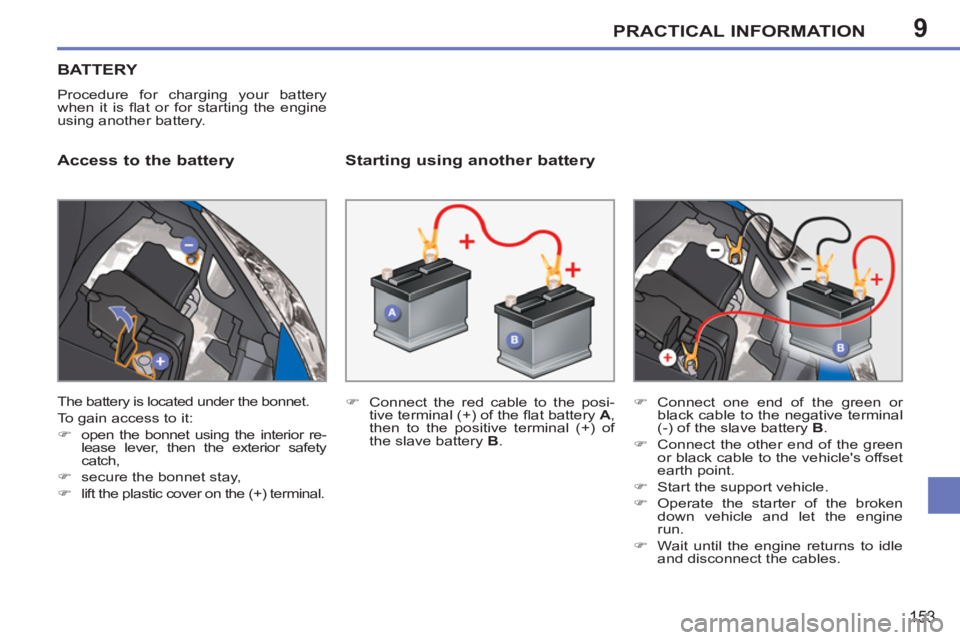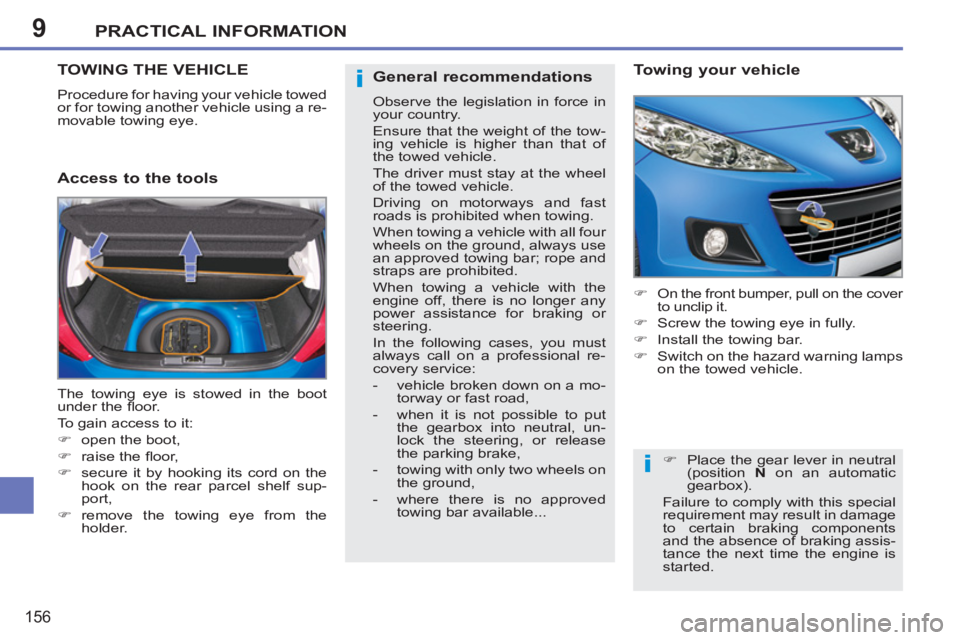2011 PEUGEOT 207 engine
[x] Cancel search: enginePage 155 of 248

9PRACTICAL INFORMATION
153
BATTERY
Procedure for charging your battery
when it is fl at or for starting the engine
using another battery.
Access to the battery
Starting using another battery
�)
Connect the red cable to the posi-
tive terminal (+) of the fl at battery A
,
then to the positive terminal (+) of
the slave battery B
.
�)
Connect one end of the green or
black cable to the negative terminal
(-) of the slave battery B
.
�)
Connect the other end of the green
or black cable to the vehicle's offset
earth point.
�)
Start the support vehicle.
�)
Operate the starter of the broken
down vehicle and let the engine
run.
�)
Wait until the engine returns to idle
and disconnect the cables.
The battery is located under the bonnet.
To gain access to it:
�)
open the bonnet using the interior re-
lease lever, then the exterior safety
catch,
�)
secure the bonnet stay,
�)
lift the plastic cover on the (+) terminal.
Page 156 of 248

9
!
i
i
PRACTICAL INFORMATION
154
Do not charge the batteries with-
out disconnecting the terminals
fi rst.
Do not disconnect the terminals
while the engine is running.
The batteries contain harmful sub-
stances such as sulphuric acid
and lead. They must be disposed
of in accordance with regulations
and must not, in any circumstanc-
es, be discarded with household
waste.
Take used remote control batteries
and vehicle batteries to a special col-
lection point.
Charging the battery using a
battery charger
�)
Disconnect the battery from the vehicle.
�)
Follow the instructions for use pro-
vided by the manufacturer of the
charger.
�)
Reconnect starting with the negative
terminal (-).
�)
Check that the terminals and connec-
tors are clean. If they are covered with
sulphate (whitish or greenish deposit),
remove them and clean them.
It is advisable to disconnect the
battery if the vehicle is to be left
unused for more than one month.
Before disconnecting the
battery
Wait 2 minutes after switching off
the ignition before disconnecting
the battery.
Close the windows and the doors
before disconnecting the battery.
Following reconnection of the
battery
Following reconnection of the bat-
tery, switch on the ignition and wait
1 minute before starting to permit
initialisation of the electronic sys-
tems. However, if slight diffi cul-
ties are encountered following this
operation, contact a PEUGEOT
dealer or a qualifi ed workshop.
Referring to the corresponding
section, you must yourself reini-
tialise:
- the remote control key,
- the one-touch electric windows,
- the GPS satellite navigation
system.
Disconnecting the cables
Reconnecting the cables
�)
Position the open clip 1
of the cable
on the positive terminal (+) of the
battery.
�)
Press vertically on the clip 1
to position
it correctly against the battery.
�)
Lock the clip by spreading the position-
ing lug and then lowering the tab 2
.
�)
Raise the locking tab fully.
Do not force the tab as locking will
not be possible if the clip is not po-
sitioned correctly; start the proce-
dure again.
Page 157 of 248

9
i
i
PRACTICAL INFORMATION
155
LOAD REDUCTION MODE
System which manages the use of cer-
tain functions according to the level of
charge remaining in the battery.
When the vehicle is being driven, the load
reduction function temporarily deactivates
certain functions, such as the air condition-
ing, the heated rear screen...
The deactivated functions are reactivat-
ed automatically as soon as conditions
permit.
A fl at battery prevents the engine
from starting (refer to the corre-
sponding paragraph).
If the telephone is being used at this
time, it will be maintained for 5 minutes
with your Peugeot Connect Sound's
Bluetooth system.
ENERGY ECONOMY MODE
System which manages the duration of
use of certain functions to conserve a
suffi cient level of charge in the battery.
After the engine has stopped, you can
still use functions such as the audio
equipment, windscreen wipers, dipped
beam headlamps, courtesy lamps, etc.
for a maximum combined duration of
thirty minutes.
Exiting economy mode
These functions are reactivated auto-
matically next time the vehicle is driven.
�)
In order to resume the use of these
functions immediately, start the en-
gine and let it run for a few minutes.
The time available to you will then be
double the duration for which the engine
is left running. However, this period will al-
ways be between fi ve and thirty minutes.
Switching to economy mode
Once the thirty minutes are over, a
message appears on the multifunction
screen indicating that the vehicle has
switched to economy mode and the ac-
tive functions are put on standby.
CHANGING A WIPER BLADE
Procedure for replacing a worn wiper
blade with a new one without the use
of tools.
Removing a front or rear wiper
blade
�)
Raise the corresponding wiper arm.
�)
Unclip the wiper blade and remove it.
Fitting a front or rear wiper
blade
�)
At the front, check the size of the
wiper blade as the shorter blade is
fi tted on the right-hand side of the
vehicle.
�)
Put the corresponding new wiper
blade in place and clip it.
�)
Fold down the wiper arm carefully.
Page 158 of 248

9
i
i
PRACTICAL INFORMATION
156
TOWING THE VEHICLE
Procedure for having your vehicle towed
or for towing another vehicle using a re-
movable towing eye.
Access to the tools
Towing your vehicle
�)
On the front bumper, pull on the cover
to unclip it.
�)
Screw the towing eye in fully.
�)
Install the towing bar.
�)
Switch on the hazard warning lamps
on the towed vehicle.
The towing eye is stowed in the boot
under the fl oor.
To gain access to it:
�)
open the boot,
�)
raise the fl oor,
�)
secure it by hooking its cord on the
hook on the rear parcel shelf sup-
port,
�)
remove the towing eye from the
holder.
�)
Place the gear lever in neutral
(position N
on an automatic
gearbox).
Failure to comply with this special
requirement may result in damage
to certain braking components
and the absence of braking assis-
tance the next time the engine is
started.
General recommendations
Observe the legislation in force in
your country.
Ensure that the weight of the tow-
ing vehicle is higher than that of
the towed vehicle.
The driver must stay at the wheel
of the towed vehicle.
Driving on motorways and fast
roads is prohibited when towing.
When towing a vehicle with all four
wheels on the ground, always use
an approved towing bar; rope and
straps are prohibited.
When towing a vehicle with the
engine off, there is no longer any
power assistance for braking or
steering.
In the following cases, you must
always call on a professional re-
covery service:
- vehicle broken down on a mo-
torway or fast road,
- when it is not possible to put
the gearbox into neutral, un-
lock the steering, or release
the parking brake,
- towing with only two wheels on
the ground,
- where there is no approved
towing bar available...
Page 160 of 248

9
i
PRACTICAL INFORMATION
158
Driving advice
Distribution of loads
�)
Distribute the load in the trailer so
that the heaviest items are as close
as possible to the axle and the nose
weight approaches the maximum
permitted without exceeding it.
Air density decreases with altitude, thus
reducing engine performance. Above
1 000 metres, the maximum towed load
must be reduced by 10 % for every
1 000 metres of altitude.
Refer to the "Technical Data" section for
details of the weights and towed loads
which apply to your vehicle.
Side wind
�)
Take into account the increased
sensitivity to side wind.
Cooling
Towing a trailer on a slope increases
the temperature of the coolant.
As the fan is electrically controlled, its
cooling capacity is not dependent on
the engine speed.
�)
To lower the engine speed, reduce
your speed. Driving with a trailer places greater de-
mands on the towing vehicle and the
driver must take particular care. The maximum towed load on a long in-
cline depends on the gradient and the
ambient temperature.
In all cases, keep a check on the coolant
temperature.
Braking
Towing a trailer increases the braking
distance.
Tyres
�)
Check the tyre pressures of the towing
vehicle and of the trailer, observing the
recommended pressures.
Lighting
�)
Check the electrical lighting and sig-
nalling on the trailer.
The rear parking sensors will be
deactivated automatically if a gen-
uine PEUGEOT towbar is used.
�)
If the warning lamp and the
STOP
warning lamp come
on, stop the vehicle and
switch off the engine as
soon as possible.
Page 164 of 248

10
162
TECHNICAL DATA
*
Not available on SW Outdoor. MODELS:
ENGINES AND GEARBOXES
PETROL ENGINES
1.4 litre 75 hp
*
1.4 litre VTi 95 hp
Cubic capacity (cc)
1 360
1 397
Bore x stroke (mm)
75 x 77
75 x 77
Maximum power: EU standard (kW)
54
70
Maximum power engine speed (rpm)
5 400
6 000
Maximum torque: EU standard (Nm)
11 8
136
Maximum torque engine speed (rpm)
3 300
4 000
Fuel
Unleaded
Unleaded
Catalytic converter
Yes
Yes
GEARBOXES
Manual
(5-speed)
Manual
(5-speed)
OIL CAPACITIES (in litres)
Engine (with fi lter replacement)
3.25
4.25
Page 165 of 248

10TECHNICAL DATA
163
MODELS:
ENGINES AND GEARBOXES
PETROL ENGINES
1.6 litre VTi 120 hp
1.6 litre THP 156 hp **
Cubic capacity (cc)
1 598
1 598
Bore x stroke (mm)
77 x 85.8
77 x 85.8
Maximum power: EU standard (kW)
88
115
Maximum power engine speed (rpm)
6 000
5 800
Maximum torque: EU standard (Nm)
160
240
Maximum torque engine speed (rpm)
4 250
1 400
Fuel
Unleaded
Unleaded
Catalytic converter
Yes
Yes
GEARBOXES
Manual
(5-speed)
Automatic
(4-speed)
Manual
(6-speed)
OIL CAPACITIES
(in litres)
Engine (with fi lter replacement)
4.25
4.25
4.25
**
Only on 5-door saloon.
Page 166 of 248

10
164
TECHNICAL DATA
The GTW and towed load values indicated apply up to a maximum altitude of 1 000 metres; the towed load mentioned must
be reduced by 10 % for each additional 1 000 metres of altitude.
The speed of a towing vehicle must not exceed 60 mph (100 km/h) (comply with the legislation in force in your country).
High ambient temperatures may result in a reduction in the performance of the vehicle in order to protect the engine; when
the ambient temperature is higher than 37 °C, limit the weight towed.
SALOON WEIGHTS AND TOWED LOADS (in kg)
Petrol engines
1.4 litre 75 hp
Gearboxes
Manual
- Kerb weight
1 214 - 1 201 - 1 207/1 248
- Gross vehicle weight (GVW)
1 617 - 1 601 - 1 582
- Gross train weight (GTW)
2 397 - 2 421 - 2 412
- Braked trailer (within GTW limit)
780 - 820 - 830
- Braked trailer ** (with load transfer within
GTW limit)
950
- Unbraked trailer
600 - 600 - 590
- Recommended nose weight
38 - 38 - 46
** The weight of the braked trailer may be increased, within the GTW limit, on condition that the GVW of the towing vehicle is reduced
by the same amount; warning, towing using a lightly loaded towing vehicle may adversely affect its road holding performance.